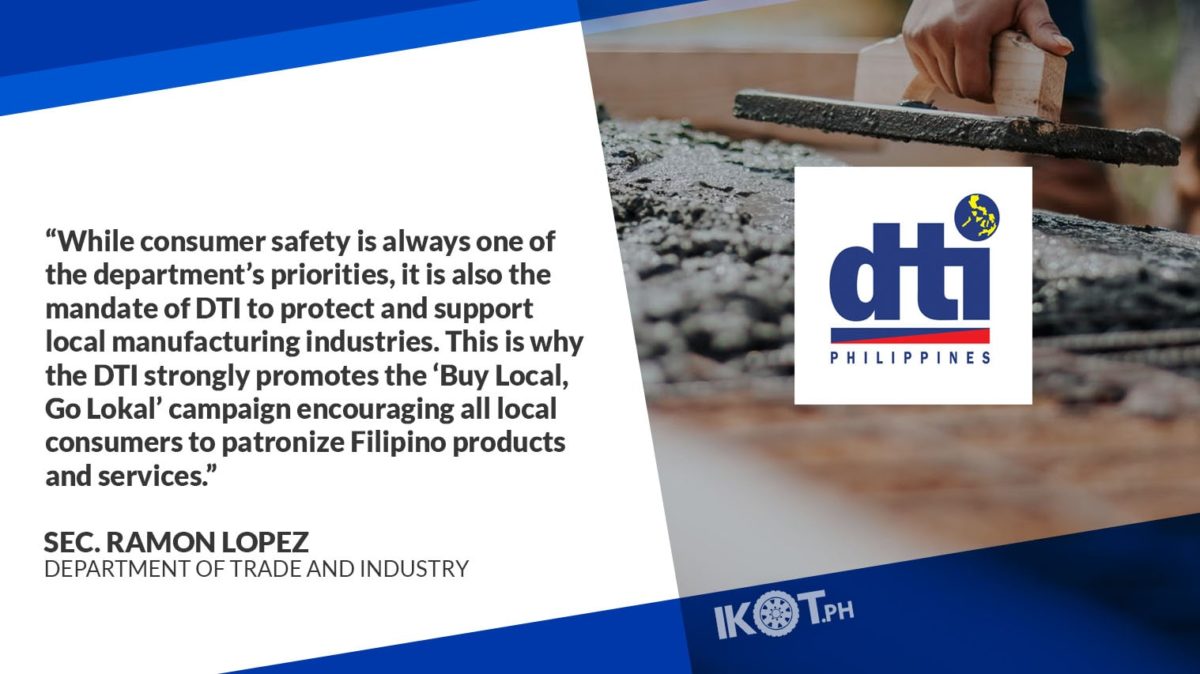The Department of Trade and Industry (DTI), through the Bureau of Philippine Standards (BPS), will be issuing a Memorandum Circular (MC) on the Supplemental Guidelines for the Implementation of Department Administrative Order (DAO) 17-06 Series of 2017 or “The New Rules and Regulations Concerning the Mandatory Certification of Portland Cement and Blended Hydraulic Cement with Pozzolan”.
This came after BPS reviewed its policy on the manufacture and importation of cement products. This move stemmed from the concerns raised by local manufacturers on the imported cement products bagged in the country but was labeled as “Product of the Philippines”.
Trade Secretary Ramon Lopez reiterated the importance of transparency and accuracy of the product markings for both locally manufactured and imported cement products.
“At this time of pandemic, we encourage our countrymen to patronize locally produced products to support the economy.”
“It is incumbent upon the importers and/or manufacturers to properly label their products and reflect the country where these products were produced. It will properly guide our consumers, especially at this time of pandemic where we encourage our countrymen to patronize locally produced products to support the economy,” Lopez said.
The trade chief has been actively promoting the “Buy Local, Go Lokal” campaign to prime up the local manufacturing industries as an effect of the COVID-19 pandemic drastically hitting the country’s economy.
Consistent with DAO 17-06:2017, the DTI-BPS issued separate licenses for the manufacturing and bagging facilities on a per plant site/location basis. However, there has been some confusion on the required product markings as the earlier DAO did not include the marking requirements for bagging facilities to indicate the country of manufacture; thus, necessitating a new Circular clarifying this requirement for concerned manufacturers and/or importers.
Upon issuance of the supplemental guidelines, the DTI-BPS will be conducting verification and monitoring of cement bagging facilities in the country to ensure immediate compliance with the prescribed product markings.
Under this MC, all locally manufactured and imported cement products shipped in bulk and bagged in a PS Licensed bagging facility shall be permanently marked with the name and address of the manufacturer, the country of manufacture, and the words “Bagged by:”, followed by the name and address of the bagging facility, among others.
In addition, manufacturers and operators of bagging facilities are directed to immediately cease all printing operations of previously approved cement bag designs indicating “Product of the Philippines” even if the cement products are imported in bulk.
The DTI-BPS will be conducting an inventory of all printed cement bags for recording purposes and immediate corrective action to reflect the correct country of manufacture.
The trade head stressed that cement manufacturers and operators of bagging facilities must be truthful in declaring the products’ country of origin.
“Accurate information through the products’ labels should be provided to the consumers for them to make informed decisions in their choices of consumer products.”
“We encourage and support investments in additional cement processing facilities, but we will also not waiver in our pursuit to ensure level playing fields, both for locally manufactured and imported products. Accurate information through the products’ labels should be provided to the consumers for them to make informed decisions in their choices of consumer products,” he added.
“While consumer safety is always one of the department’s priorities, it is also the mandate of DTI to protect and support local manufacturing industries. This is why the DTI strongly promotes the ‘Buy Local, Go Lokal’ campaign encouraging all local consumers to patronize Filipino products and services,” Lopez said.
The new supplemental guidelines shall be effective immediately upon publication in a national newspaper of general circulation.

